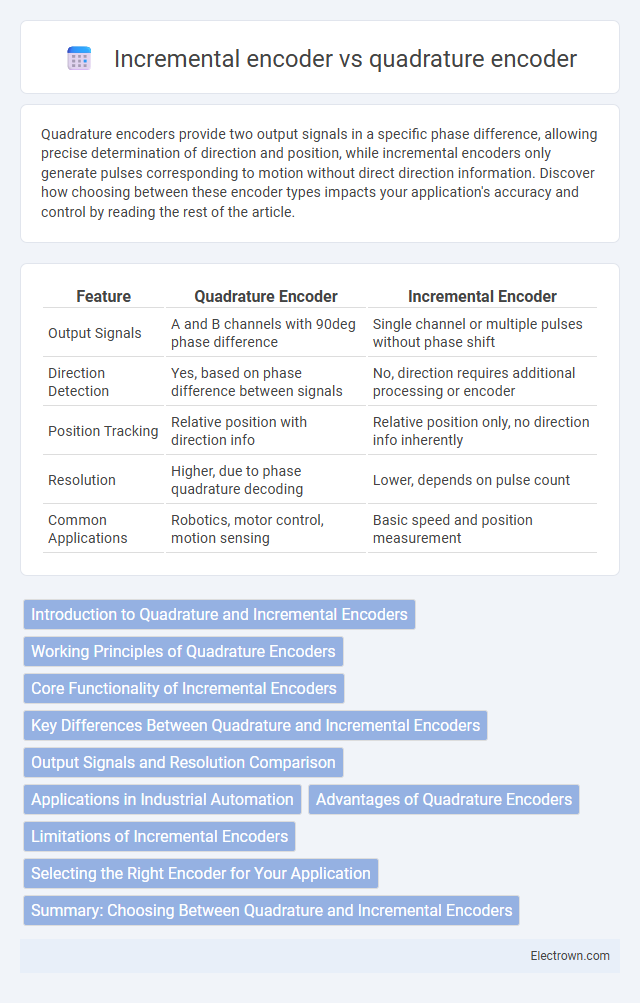Quadrature encoders provide two output signals in a specific phase difference, allowing precise determination of direction and position, while incremental encoders only generate pulses corresponding to motion without direct direction information. Discover how choosing between these encoder types impacts your application's accuracy and control by reading the rest of the article.
Table of Comparison
| Feature | Quadrature Encoder | Incremental Encoder |
|---|---|---|
| Output Signals | A and B channels with 90deg phase difference | Single channel or multiple pulses without phase shift |
| Direction Detection | Yes, based on phase difference between signals | No, direction requires additional processing or encoder |
| Position Tracking | Relative position with direction info | Relative position only, no direction info inherently |
| Resolution | Higher, due to phase quadrature decoding | Lower, depends on pulse count |
| Common Applications | Robotics, motor control, motion sensing | Basic speed and position measurement |
Introduction to Quadrature and Incremental Encoders
Quadrature encoders and incremental encoders both provide position feedback by generating electrical pulses as a shaft rotates, but quadrature encoders output two signals shifted by 90 degrees to indicate direction, enhancing accuracy in motion control systems. Incremental encoders produce a single pulse train representing movement without inherent direction information, requiring external methods to determine rotation direction. These devices are essential in robotics, CNC machines, and automation for precise speed and position measurement.
Working Principles of Quadrature Encoders
Quadrature encoders operate by generating two output signals, typically labeled A and B, that are 90 degrees out of phase, allowing precise determination of both position and direction of movement. These signals are processed by counting the pulses and analyzing their phase difference to detect rotational displacement and speed accurately. This phase-shifted output distinguishes quadrature encoders from standard incremental encoders, which only provide pulse counts without directional information.
Core Functionality of Incremental Encoders
Incremental encoders measure angular position by generating two output signals, A and B, which produce pulses corresponding to shaft rotation, allowing determination of direction and speed. Quadrature encoders are a specific type of incremental encoder that use phase-shifted signals to enhance resolution and accurately track direction by decoding the sequence of pulses. The core functionality of incremental encoders centers on pulse generation for position tracking, with quadrature encoding providing improved precision and directional information.
Key Differences Between Quadrature and Incremental Encoders
Quadrature encoders provide two output signals in quadrature phase, enabling precise direction detection and higher resolution pulse counting compared to standard incremental encoders, which typically generate a single pulse per increment. Incremental encoders measure position changes through pulse counts but lack inherent direction information without additional signal processing. Quadrature encoders are preferred in applications demanding accurate directional feedback and velocity measurement, while incremental encoders are primarily used for simple position tracking and speed sensing.
Output Signals and Resolution Comparison
Quadrature encoders provide two output signals, A and B, which are 90 degrees out of phase, enabling precise detection of both position and direction of rotation. Incremental encoders share similar pulse outputs but often lack the phase difference, limiting directional sensing without additional processing. Your choice benefits from the quadrature's higher resolution accuracy, as it effectively doubles the count pulses per revolution compared to standard incremental encoders.
Applications in Industrial Automation
Quadrature encoders provide precise directional feedback ideal for robotic arms, CNC machines, and conveyor systems requiring accurate position control. Incremental encoders excel in applications needing simple speed and position measurement, such as motor speed monitoring and elevator control. Both encoder types integrate with PLCs and motion controllers to enhance automation efficiency and reliability in manufacturing environments.
Advantages of Quadrature Encoders
Quadrature encoders provide precise position and direction information by generating two output signals offset by 90 degrees, enabling accurate detection of rotational movement with high resolution. Their ability to detect the direction of rotation and offer greater noise immunity makes them superior to basic incremental encoders in complex control systems. You benefit from enhanced motion control and reliable feedback for applications requiring exact speed and position monitoring.
Limitations of Incremental Encoders
Incremental encoders face limitations such as inability to provide absolute position information, which requires a reference point or homing sequence after power loss. Quadrature encoders overcome this by offering direction detection through phase-shifted signals, enhancing position tracking accuracy. Your system may experience errors in high-speed or noisy environments due to signal miscounts in basic incremental encoders.
Selecting the Right Encoder for Your Application
Quadrature encoders provide precise direction and position feedback by generating two output signals 90 degrees out of phase, ideal for applications requiring accurate motion control. Incremental encoders, while simpler and cost-effective, only supply pulse counts for speed and distance without inherent direction information, suitable for basic speed measurement tasks. Selecting the right encoder depends on the specific application's need for directional feedback, resolution, and budget constraints.
Summary: Choosing Between Quadrature and Incremental Encoders
Quadrature encoders provide two output signals 90 degrees out of phase, enabling precise direction and position detection, while incremental encoders generate pulses indicating motion but lack inherent directional data. Your choice depends on the application requirements: quadrature encoders suit systems needing accurate speed and direction control, whereas incremental encoders are ideal for monitoring simple rotational or linear movements. Understanding these distinctions ensures optimal selection for enhancing sensor accuracy and control performance in automation and robotics.
Quadrature encoder vs incremental encoder Infographic

 electrown.com
electrown.com